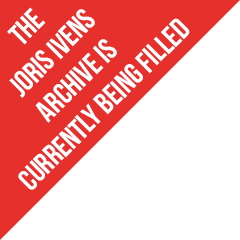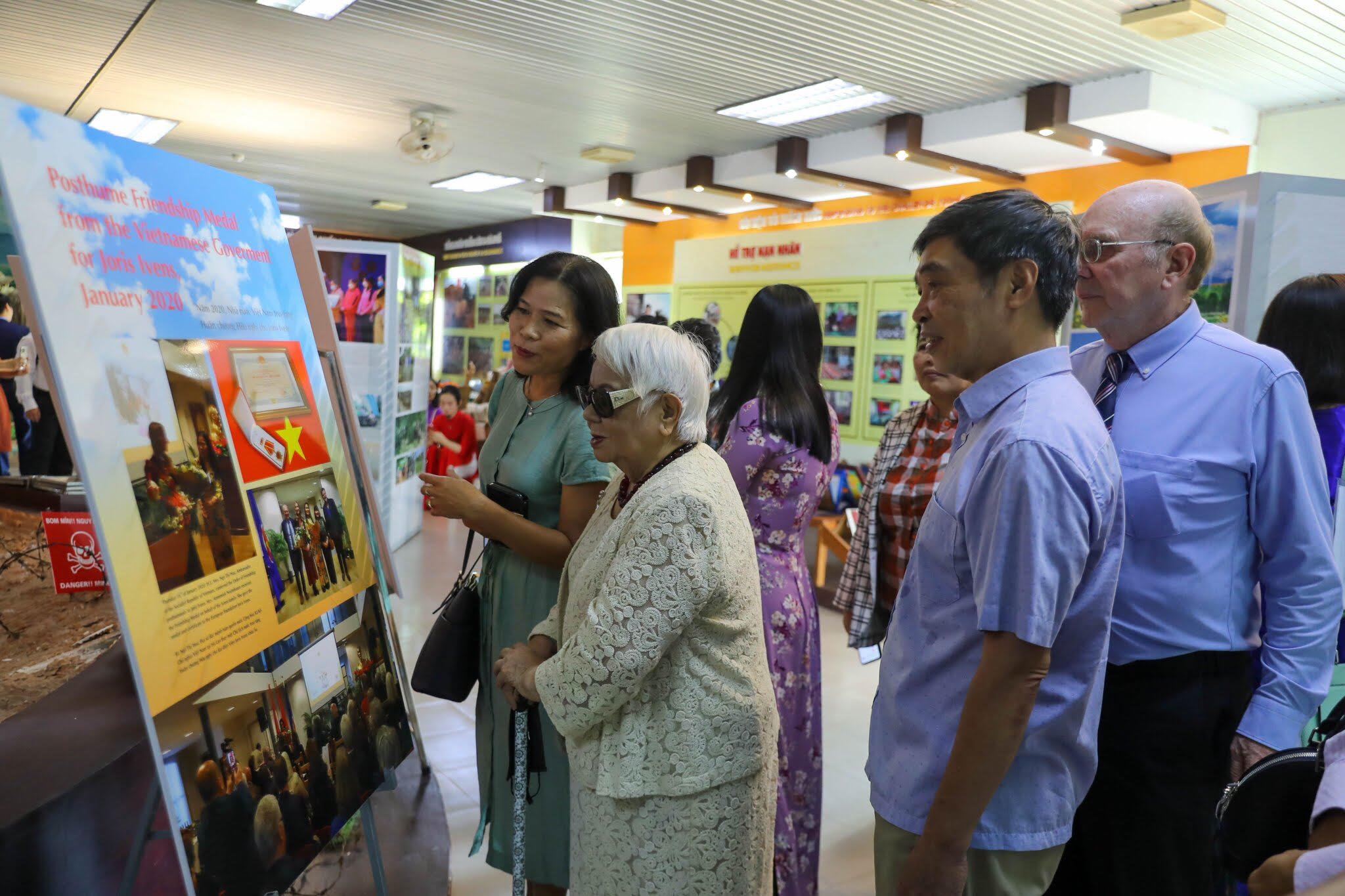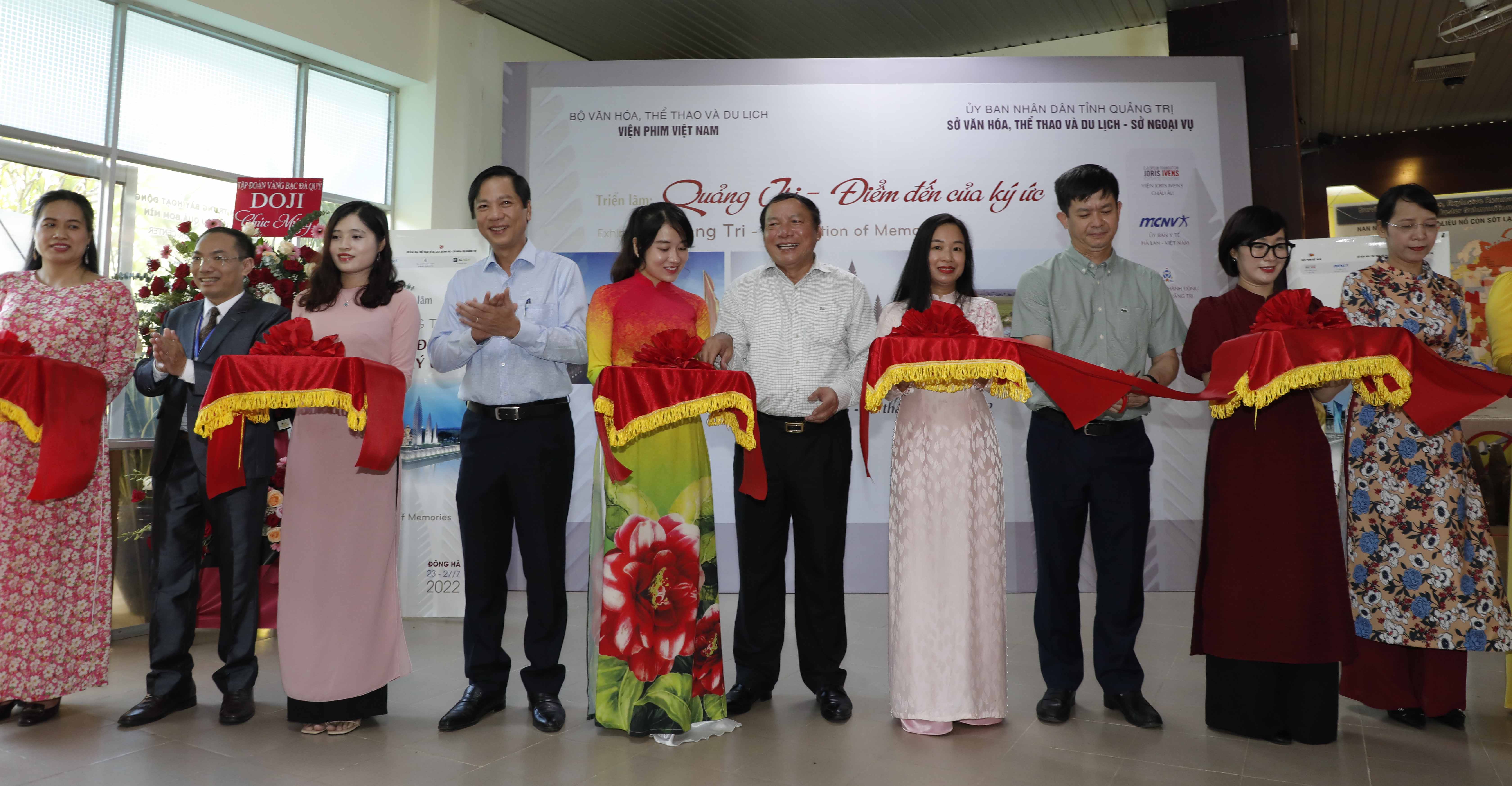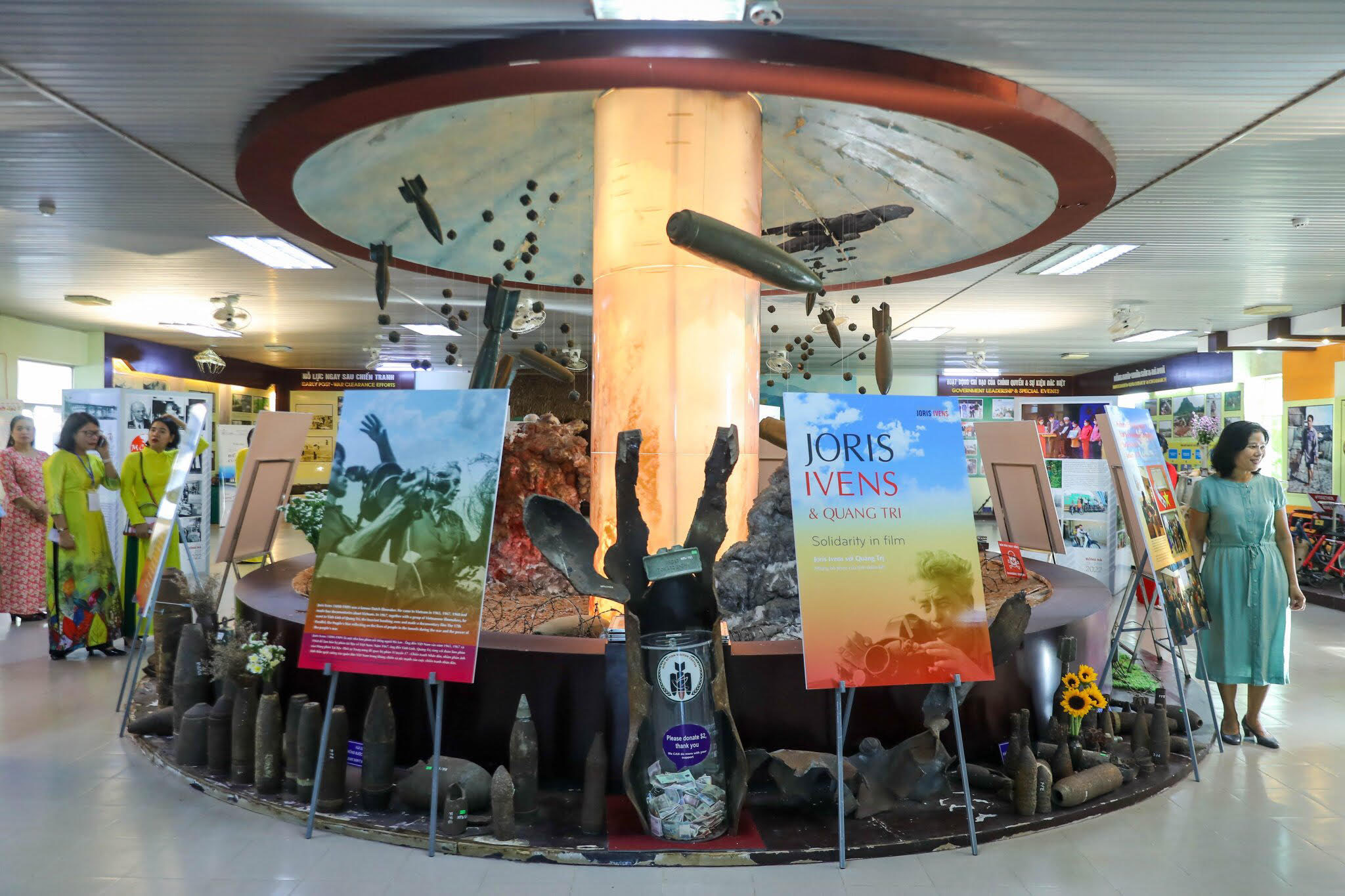

Op maandag 25 juli opende de Vietnamese minister van cultuur en toerisme, mr. Nguyen Van Hung, een expositie in het Quang Tri Mine Action Centre (QTMAC) en 'Restoring the Environment and Neutralizing the effects of the War' (RENEW). over Joris Ivens en het Medische Comité Nederland-Vietnam (MCNV). De Ivens Stichting vervaardigde in nauwe samenwerking met het Vietnam Film Instituut de panelen over de relatie van Joris Ivens en Marceline Loridan-Ivens met Vietnam tussen 1965 en 1970. Hun steun aan de bevrijdingsoorlog resulteerde in vier films, o.a. de in Quang Tri verfilmde 17e breedtegraad (le 17e parallele).
Naast de minister van cultuur en toerisme waren voormalige ambassadeurs van Nederland in Vietnam en Vietnamese ambassadeurs in Nederland aanwezig, o.a. mevr. Ngo Ho Thoa. Mr. Hoang Nam, vice-voorzitter van het Volkscomité van Quang Tri speelde een belangrijke rol bij de verwezelijking van dit project, dat beoogd het herinneringstoerisme in de provincie Quang Tri te bevorderen. Hij was in 2019 hoofd van de delegatie die Nederland bezocht, o.a. Nijmegen.
Onder de sprekers van de aansluitende conferentie was mevr. Xuan Phuong, een naaste medewerker van Joris Ivens gedurende de opnames van de Vietnamese films. Hoewle opgeleid als dokter werd zij d evertaler en persoonlijk assistent van Ivens en wel 'drie mannen'waard. na de oorlog opende zij een kunstgalerie in Ho Chi Minh Stad en stimuleert de promotie van hedendaagse Vietnamese kunstenaar sin zowel Vietnam als in het buitenland (o.a. Australië, Frankrijk).
Een andere spreker was Ad Spijkers, voormalig vertegenwoordiger van de FAO (Food and Agricultural Organisation of the United Nations) en adviseur van de Ivens Stichting. Hij besteedde aandacht aan de historie van Joris Ivens in Vietnam en de steunacties in Nederland, die o.a. resulteerde in de bouw in 1975 van een compleet hospitaal in Quang Tri, het zwaarst gebombardeerde gebied van Vietnam. Het Medisch Comité Nederland-Vietnam was destijds opgericht en is - na meer dan vijftig jaar - immer actief in de gezondheidszorg van Vietnam en Laos.
Gedurende de voorbereiding van de expositie vond de Ivens Stichting eindelijk het bewijs Joris Ivens de korte reportage heeft gemaakt over president Ho Chi Minh in 1969, het jaar dat de legendarische leider van de onafhankelijkheidsstrijd, overleed. Hij zit in de tuin van het presidentiele paleis, waar hij soldaten verwelkomd van het front en met hen de militaire situatie bespreekt. De reportage was met een zeer slechte filmcamera opgenomen, die schokkerige beelden opleverden, zo schreef Ivens in een brief. Ondanks de zwakke kwaliteit van de beelden leverde het unieke beelden in kleur op van de president.
Het Landmijn Centrum van Quang Tri is een zeer geschikte locatie voor deze expositie, want het laat de gevolgen zien van de zware bombardementen en de vele landmijnen, die to op de dag van vandaag nog steeds slachtoffers eisen. Het MCNV wordt gesteund door zowel USAID als de EU.
Mevr. Xuan Phuong bekijkt de tentoonstellingspanelen, samen met de voormalige ambassadeur van Vietnam in Den Haag, mevr. Hoa Ngo Thi, journalist Nhan van Nguyen en Mr. Ad Spijkers. Foto copyright Tran Le Hieu / MCNV, 25072022.
De toespraak van Mr. Ad Spijkers:
“Valuable footage of Joris Ivens in 1967 will remain in the Quang Tri history - Solidarity in action in the Netherlands for Vietnam during the war and afterwards”
1. Allow me to have a few words about the European Foundation Joris Ivens (EFJI) which was established in 1990 in memory of the life and work of Joris Ivens. During his career between 1912 and 1988, he made more than 80 films in over 20 countries. His life and work provide a unique insight in the turbulent 20th century. He witnessed many conflicts and wars from Spain, Cuba, China, Russia, Mali, Chili to Indonesia and Vietnam. Born in Nijmegen in the Netherland in a family trading with cinema equipment’s, he developed a passion for filming from his early age.
2. He was drawn to the world turbulence before World War II and after, that led him to hot spots of conflict zones with his camera. He made “ The Spanish Earth” in Spain between 1936-1942, together with Ernest Hemingway, a famous writer.
3. ‘Indonesia Calling’ is a 1946 Australian short documentary film directed by Joris Ivens supporting the struggle for Indonesian Independence. He was in China during the resistance war in 1938, after the war in 1958 and later on during the Cultural Revolution in China in 1966 – 1976.
4. From 1965-1970 he devoted himself to the liberation struggle of Vietnam and made four films against the war in Vietnam. The “The 17th Parallel, the People’s War” produced in 1968 after his visit to Vinh Linh in 1967. He met President Ho Chi Minh and General Giap. With the permission of Ho Chi Minh, together with his wife Marceline Loridan and a group of Vietnamese filmmakers, Joris travelled to an area dividing the country those days, Vinh Linh, Quang Tri. After two months living underground, capturing daily villagers life in an fierce war zone, he came back to Paris and completed this documentary. The endurance and hardship that the people of Quang Tri strived to overcome and their strength touched him. It is not possible to win a long, protracted war without popular support, and Joris Ivens understood this well. The film went in premiere with success in 1968 and had a strong influence on anti-war movements emerging widely in Europe. “The 17th Parallel, the People’s War” made by Joris Ivens will remain a valuable legacy in the history of Quang Tri.
5. In the 60s and 70s, when the war in Vietnam was at its fiercest stage, anti-war movements and solidarity with Vietnam in Europe and America emerged. I was barely 20 years old and drawn to these movements - supporting humanitarian initiatives like the purchase of medicines and health-equipment. The Medical Committee Netherlands Vietnam (MCNV) was established in November 1968. Activities such as large-scale collection of money through auctions of works of art, were made available free of charge by hundreds of artists. It was a broad social movement which got good support from all layers of the society. There were actions such as :“bicycles for Vietnam”, “sewing machines for Vietnam” and ‘boats for Vietnam’. The use of the medical and transport bikes in the battle in Vietnam was a good inspiration for us.
6. After the war we continued to provide humanitarian assistance.. In this period the MCNV decided to send a complete prefabricated hospital with full equipped specialized departments to Vietnam. The parts were shipped in 1974 to Haiphong. The hospital was built in Dong Ha, Quang Tri province which was completely destroyed by bombings. The provisional government of the South made the correct choice. The equipment for the departments of the hospital was realized thanks to financial contributions of individuals and the efforts of Dutch universities where Nijmegen took the lead alongside the universities of Groningen, Utrecht, Leiden, Amsterdam, and three other technical universities. Subsequently many Vietnamese doctors and pharmacists went to the Netherlands for post-graduate training. This assistance was organized by the medical faculties of Dutch universities with adequate financial support of the Dutch minister for development cooperation Mr. Jan Pronk.
7. Mr. Chairman, nowadays, MCNV is still active in Quang Tri and has accompanied Quang Tri for more than 50 years. Some Dutch people supported MCNV from its foundation and continue it until today. I am very happy that USAID and the EU become MCNV main partners to support financially the work of MCNV. The Medical Committee Netherlands Vietnam present today here can be proud to be the pioneer of medical and development assistance in Quang Tri and elsewhere in the country.
8. In 2018 in close cooperation with the Vietnam Film Institute we organized in Hanoi an international symposium about Joris Ivens. We made a trip to “the former Battle Fields” in Vinh Linh to visit souvenir sites where Joris Ivens and his wife stayed underground and filmed. The Foundation has given all materials made by Joris Ivens about Vietnam to the Vietnam Film Institute.
9. Dear Friends, a delegation of leaders and businesses companies of Quang Tri has visited the Netherlands including Nijmegen in 2019. It marks a possible new connection for the future. The subjects are relevant for the development of the province such as: renewable energy, clean drinking water, waste management; animal feed; wood pallets & furniture; industrial crops (coffee, pepper, rubber), tourism and logistics. Also how the chain of waste processing is dealt with is an important subject for the province. Vietnam in general and Quang Tri in particular must face environmental challenges and sustainable development to have a strong economy.
10. For a Vietnam Doi Moi today, the war's past is a lesson and the new generation will continue to strive for a lasting peace by honoring those who have sacrificed, and by working hard for a better future of the country. And the province Quang Tri will certainly be a part of this change. We wish Quang Tri every success and that it become a safe and friendly destination that people from home and abroad to visit. My first visit to this area was in December 1976 and now nearly 50 years later there are many positive changes. A good vision, hard work and an iron will was needed.
CLIP Joris Ivens in Hanoi in 1965: from 27min. till 30min. https://youtu.be/yi4psTCMtNA?t=1367
Afterword:
- From medicines and ‘bicycles for Vietnam’ to DNA technology for identification of the war victims of the long war – a project of the Government of Vietnam with advanced technology from Nijmegen.
- Vietnam making the country by 2030 one of the top 10 agricultural processing hubs.
- Vietnam- contributor to World Food Security, from food shortage in the ‘70’s now became an important exporter of rice and other high value industrial crops. Significant element for Peace and Stability on the Planet.
Dong Ha, July 25, 2022
Ad Spijkers - Former FAO Representative and advisor EFJI (Vietnam)

De Vietnamese minister van Culture en Toerisme, Mr. Nguyen Van Hung (in het midden), opent de expositie in het Quang Tri Mine Action Centre (QTMAC). Mr. Hoang Nam, vice-voorzitter van het Volkscomité van Quang Tri applaudiseert (4e van links). Foto copyright Tran Le Hieu / MCNV, 25072022.
De toespraak van Mr. Chuck Searcy:
QUANG TRI - 50 YEARS OF ASPIRATION FOR PEACE
Chuck Searcy, Adviser for Project RENEW and President of Veterans
for Peace, Chapter 160 Vietnam, NGO Agent Orange: “Building a culture of peace and healing the wounds of war”.
Peace is precious, three words that were carved on precious wood and red lacquer trimmed with gold, put in these formal places and respected for generations. That is a beautiful philosophy of life, a special ideology of Vietnam and the Orient. Throughout time it becomes the measure of kindness . . . It rejects the philosophy of venerating power, using violence to deter and conquer other nations as the only way to solve difficulties in the world. It must be because we are a nation that has been through the pain of war that we have a burning desire for peace.
– Poet Hu’u Thinh, Chairman of the Vietnam Writers’ Association, from the Preface of his book.
“Building a culture of peace.” What does it mean?
Culture is the quality in a person or society that creates excellence in arts, letters, manners, scholarship, and relationships. It encourages improvement of the mind. Minds improve collectively, and society benefits, cultures blossom. Culture may need decades or centuries, and generations, to mature. Rich civilizations are created through this growth, just as orchids are cultivated and they become beautiful flowers.
As an American, I feel somewhat out of place speaking to Vietnamese about culture. After all, Vietnamese culture has been around for 4,000 thousand years. America, as a nation and a culture, has only been around less than 300 years.
The culture of Viet Nam, from the family and the village level to the national level, embraces mixed roles of leadership and duty among village elders, kings, respected leaders such as Ho Chi Minh. It is built on balance and stability in institutions such as Buddhism and the Communist Party’s leadership. All of these fall under the banner of harmony, duty, honor, respect, education and allegiance to the family and the nation.
Those cultural values have been a strong foundation for Viet Nam as a society and a nation, and permitted this small country to survive and to prevail against attacks, invasions, occupations, storms and floods and other man-made and natural devastation. In every case, the Vietnamese have maintained their unity, their dignity, and their solidarity, and eventually Viet Nam has always regained its independence and freedom and restored the homes and rice fields of the people. Such strength and resiliency constitute one of Viet Nam’s strongest cultural values, which also guarantees Viet Nam’s sovereignty: the determination of the Vietnamese people to never give up their independence and freedom.
Viet Nam has shown the world that a culture of peace can open a pathway to tranquility, harmony, forgiveness, and a bright and safe future. Viet Nam has shown us how to teach children about peace, about sharing, about putting aside selfishness and thinking of others. The children grow to become young adults and future leaders, and they carry with them the lessons of peace they learned from their parents. They are the global leaders of the future.
Viet Nam carries the culture of peace to another dimension, however: when Viet Nam finally defeats and expels the invaders and the occupiers, the Vietnamese remove them with grace and dignity. The Vietnamese do not humiliate their defeated former enemies; they treat them with respect, knowing that some day they may again be friends. The Vietnamese have great compassion, and great understanding of the hearts of human beings. They know that making a new friend will be a stronger bond and better guarantee peace than crushing an enemy in the dust – which will leave a taste of anger and revenge.
The Vietnamese can teach the world about a culture of peace, continuing to lead by example.
I can tell you, as an American veteran of the war in 1967 and 1968, in Sai Gon, a US Army intelligence analyst, that even during the war I learned from Vietnamese friends how precious is peace to the people of Viet Nam. That’s a special word, precious – quí. We don’t use it much in English. But in Viet Namese precious has an enhanced meaning that all Vietnamese understand. They know that peace is indeed precious.
When I was leaving Sai Gon in June, 1968 my closest Vietnamese friend, a soldier in the Saigon army, said to me as we were saying goodbye, “Go in peace, my friend. I wish you well. And please take every other American soldier with you. Because until you Americans leave our country, we will not have peace. Vietnamese know from centuries of history how to make peace – how to talk with each other, how to reach understandings, how to compromise. We know how to make peace. But you Americans will not let us have peace. You want only war, and victory, but a victory that is different from what the Vietnamese people want.”
He was right. As I look back on that conversation in June of 1968, the last time I saw him, I remember thinking, the Vietnamese are seeking their independence and freedom, which can only be guaranteed by peace. The US is only seeking victory. And we did not even know what that meant.
The end of the war in 1975 stopped the fighting, the bombing, the death and destruction. But the peace that followed was a difficult time for the people of Viet Nam, a time of hard labor, lack of food, lack of opportunity, a time of struggle and sacrifice. It was a time when healing was needed, but that was a difficult challenge. Yet the Viet Namese people did not complain. They redoubled their efforts to rebuild their nation from the rubble of war. They labored under the banner of a hard-won peace, savoring their independence and freedom. They knew how precious peace was, and they were determined to keep it.
War leaves many wounds, and sometimes the scars are visible for a lifetime. To heal a wound, we must first clean the injury, to allow sunshine to restore health and wholeness. That is true of history, also. To learn from history, to avoid making mistakes of the past, we must accept the truth, we must expose wounds of the heart and soul to the healing sunshine of truth.
American veterans of the war – thousands of us who have returned to Viet Nam over the past nearly 50 years – have learned much from our Vietnamese friends about healing, not just about healing the physical injuries but also the psychological wounds of war. The welcome we have received from the people of Viet Nam, and from Vietnamese veterans, former enemies, has been warm and embracing. The forgiveness and the compassion we have received from the Vietnamese have been unexpected and overwhelming. American veterans quickly discover that the Vietnamese people don’t hate us, in fact they welcome us as friends, especially if we offer to help in Viet Nam’s continuing recovery from the damage and destruction, the legacies of the war, including explosive ordnance and Agent Orange.
I have seen American veterans weep on the shoulders of Vietnamese veterans when they hear these words. For some, they truly feel forgiveness for the first time. They feel compassion from the Vietnamese that they did not get back home in America.
Some American veterans still suffer feelings of guilt, betrayal by the U.S. government with the lies that we were told, and anger that we were forced to do something that we deeply regret today.
The Vietnamese people kindly say to us, “That was a long time ago – it was not your fault. The US government made the decisions, and you obeyed. You served your country, we respect that. You know how we Vietnamese suffered, because you suffered also. Today we are brothers and sisters, friends.”
I have seen so many American veterans reach out and embrace Vietnamese veterans, or mothers or children of Vietnamese veterans, who hug them and share with them powerful healing. In more than 25 years in Viet Nam I have met so many US veterans who have come here with their minds and hearts in turmoil. After two or three weeks in Viet Nam, meeting Vietnamese and sharing special moments together, every American veteran I know has returned home to America with his life changed for the better.
That is true healing. We owe so much to our Vietnamese friends for sharing those bonds of forgiveness and friendship.
Many of us American veterans have tried to give back, in small ways, to help Viet Nam recover from the consequences of the war. An American veteran, George Mizo, saw the need for medical support and rehabilitation for children and veterans suffering from Agent Orange, so George joined with the Vietnamese veterans’ association to build and operate a Peace Village on the edge of Ha Noi, which has served hundreds of veterans and children of veterans with care and treatment.
Other veterans have helped build or renovate schools, orphanages, other community facilities, and many have volunteered to work in those institutions.
I am fortunate to work with Project RENEW in Quang Tri Province, a cooperative effort to reduce and eliminate the threat and the harm from bombs and mines. RENEW teams, working with Norwegian People’s Aid (NPA), PeaceTrees, MAG and other organizations, have destroyed more than 800,000 bombs over the past two decades. From 75 or 80 casualties every year two decades ago, starting in 2018 the accident rate in Quang Tri Province dropped to zero. For four years there was not a single accident in Quang Tri. Unfortunately, this year there have been two accidents this year – a sad reminder that the problem will not ever go away. It must be managed and monitored every day, to protect children today and in the future.
American veterans have also worked with Vietnamese veterans – the veterans association, the Vietnam Association of Victims of Agent Orange, and others – to deal with the terrible consequences of Agent Orange. Two major dioxin hot spots in Viet Nam have now been cleaned up, and one is being cleaned up now, helping to make Viet Nam safe from toxic contamination. Partly because of urging from American veterans, the US government has finally agreed to provide $65 million over the next three years to help families who are facing problems from their children with severe disabilities, likely caused by Agent Orange.
And veterans from all sides have worked together with the governments of the US and Viet Nam to find and account for the many missing remains of soldiers lost in the war.
We have learned – American veterans – from our Vietnamese friends the value of “giving back” in exchange for the forgiveness and the friendship we have received from the people of Viet Nam. This is another way in which the wounds of war are being healed.
I am deeply grateful to the Vietnamese people for sharing with us who have lived and worked here the important values that have made this country such a special place: a culture of peace; and understanding the need to heal the wounds of war.
How to create a culture of lasting peace is the most important challenge. With open hearts and minds, we should learn from each other.
In the words of venerable Thich Nhat Hanh, “Every breath we take, every step we make, can be filled with peace, joy and serenity.”